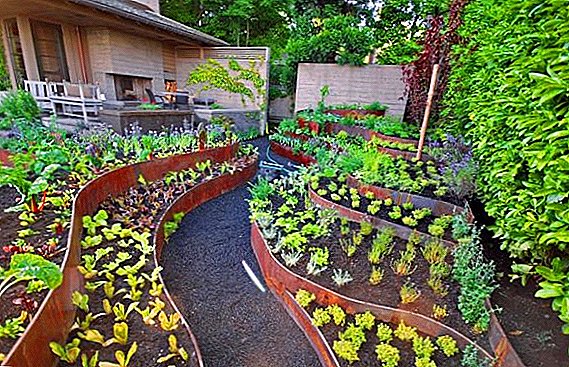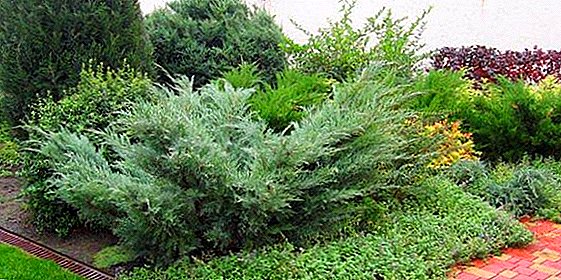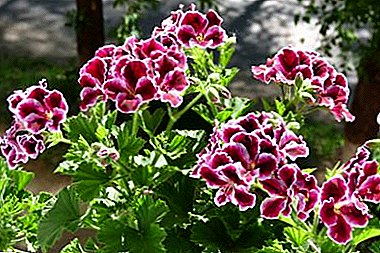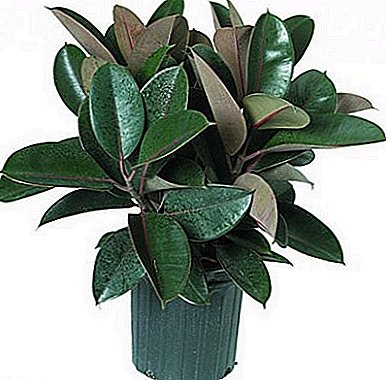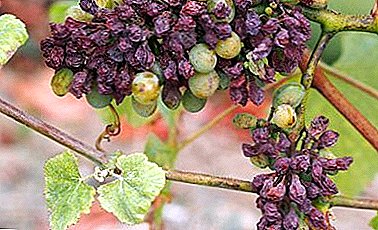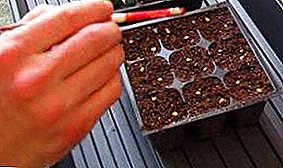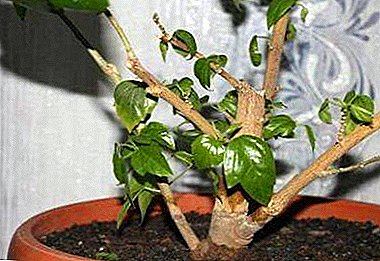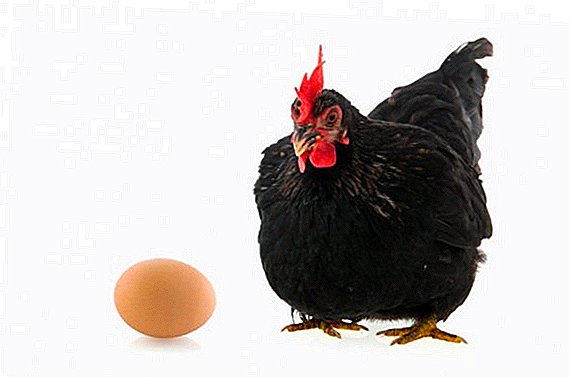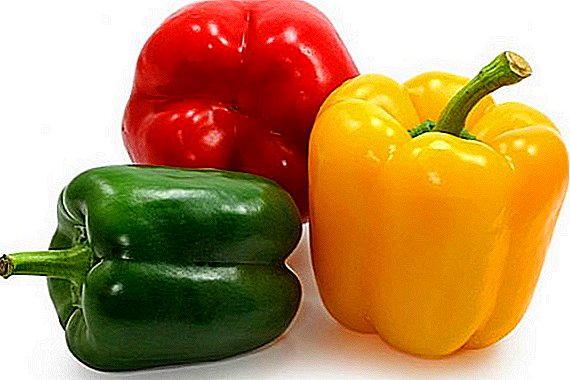 The fact that the moon phases somehow affect all life on the planet has long been known. The same explains the popularity of lunar calendars for gardeners and gardeners. Today we will talk about how to properly sow pepper in seedlings according to the lunar calendar.
The fact that the moon phases somehow affect all life on the planet has long been known. The same explains the popularity of lunar calendars for gardeners and gardeners. Today we will talk about how to properly sow pepper in seedlings according to the lunar calendar.
Conditions for growing peppers
Organizing the necessary temperature regime for the development of pepper seedlings in a residential environment is not as easy as it may seem at first glance.
You should know at least that the temperature in the apartment ceiling is 1-2 degrees higher than the average, and above the floor level it is 2-3 degrees lower. The brightest place in the room is the window sill, it turns out, it is also the coldest, but the seedlings need warmth.
But you can arrange for seedlings artificial lighting, close to natural, in a warmer place of the apartment. Being at a temperature of 26-28 ºC, pepper will germinate already the eighth-twelfth day. At a temperature of 20-26 ºC seeds will rise in the period from 13 to 17 days. At 18-20 ºC - in 18-20 days. At 14-15 ºC shoots will appear after 30 days.
 As the seeds begin to germinate, they will need to be moved closer to the light. The temperature will need to be lowered to 15 ºC for 7 days. After again raise to 23 ºC during the day and 20 ºC at night.
As the seeds begin to germinate, they will need to be moved closer to the light. The temperature will need to be lowered to 15 ºC for 7 days. After again raise to 23 ºC during the day and 20 ºC at night.
Important! Ventilate the room with seedlings regularly, but do it quite carefully. Seedlings are afraid of cold air and even more drafts.
How to choose the time for planting pepper for seedlings using the lunar calendar
Using the sowing calendar, you will learn a favorable time when it is best to plant pepper seedlings. You will learn the phase changes of the moon, on which the quality and quantity of the crop depends. You should never plant plants on the full moon and new moon.
The fact is that during these periods all nutritious juices of seedlings are collected either in the upper part or concentrated in the root system. This course of events prevents the plant to develop fully.
But if you plant pepper in the period of increasing moon, the activity of its growth will be much higher compared with the period of decreasing.
Favorable days for planting peppers for seedlings in January are as follows: 5, 6, 7, 8, 30. Only the 11th and 28th numbers are not recommended to take up this business.
Seedlings of peppers in february is safe in these numbers - 14,16, 23. There are two unfavorable days - 11 and 26.
Planting Peppers in March 4, 14, 20, 31 is desirable, and 12, 28 is undesirable.
Favorable days April - 9, 18, 27, 28, and unfavorable - 11, 26.
Favorable days for planting peppers for seedlings May the following - 8, 14, 24. Unfavorable - 11 and 25.
AT June better practice 2, 11, 20 and forget 9, 24.
Favorable days July - 3, 4, 26, 30, and unfavorable - 9, 23.
August favors 2, 22, 24, 28, and cautions 7 and 21.
Favorable days September - 5, 23, 26, 27, unfavorable - 6, 20.
AT october we sow pepper on seedlings - 3, 4, 22, 30, we do not sow - 5, 19.
Better days november - 2, 3, 19, 20, 30, and the worst - 4, 18.
December favorable 2, 20, 25, 29 and unfavorable only 3 and 18.
Did you know? The first written references to pepper were found in India. They were written in Sanskrit more than 30 centuries ago. India is considered the birthplace of pepper, even if it grows in other countries of the tropics.
Terms of planting pepper seedlings, manufacturers recommendations
To grow peppers, planting on seedlings which must occur according to several important criteria, it is not enough to use only the lunar calendar. 
To grow it in 2017, there are two important points to consider:
- Features of the landed variety.
- Is it planned to conduct a picking? If yes, then the development of the plant will be about 10 days behind.
An important role is played by the local climate conditions. Having determined the approximate date of transplanting pepper to a permanent place, subtract from this number from 60 to 85 days. Thus, the optimal date of sowing peppers for seedlings.
After that, check again with the lunar calendar for 2017. So you calculate the favorable for planting at home days and in the future will get a good harvest.
Did you know? Once pepper could pay for the goods and repay fines.
Features of growing seedlings of pepper: the choice of planting material and care for seedlings
You can choose sweet and hot peppers according to a variety of criteria, which for the most part are individual. The main condition of choice is to rely on basic criteria.
 The main varieties and hybrids of pepper must be selected with regard to the climatic characteristics of the zone in which they will be grown.
The main varieties and hybrids of pepper must be selected with regard to the climatic characteristics of the zone in which they will be grown.
In the south, gardeners are almost not limited by the choice, because there you can grow late varieties of vegetable crops that are highly productive. In the north, give a good harvest mostly early ripening varieties, ripening 14-17 weeks.
Remember that you need to choose exactly the seeds that are suitable for growing seedlings. Sowing seeds in an unprotected soil is a thankless task, as pepper cannot produce a crop before the onset of frost.
If you have inadequate conditions for sprouting seedlings in your home, then don’t bother to buy seeds. Better buy planting material in nurseries, specialty stores or garden pavilions.
After all, it is there that the greatest chance to buy exactly those varieties of pepper that you want, as well as get expert advice about seedlings. But it is not always possible to buy either seeds or seedlings in such places, so it remains to move in the direction of the market.
 When buying seedlings, pay attention that the leaves of the seedlings are sufficiently developed, of a smooth green color, there is no white bloom and stains. In general, the seedlings should look sturdy and elongated upwards.
When buying seedlings, pay attention that the leaves of the seedlings are sufficiently developed, of a smooth green color, there is no white bloom and stains. In general, the seedlings should look sturdy and elongated upwards.
If she is weak and drooping, then do not take even after the assurances of sellers that after landing she will take heart. It is not uncommon for the seedlings to be sold on the market at first glance is good and healthy, and as a result the product is illiquid.
It can overfeed with nitrogen fertilizers, growth stimulants or inhibitors, on the contrary, inhibiting development. Such a seedling blooms poorly, poorly developed and gives a poor harvest.
Unfortunately, such a trick is almost impossible to recognize at the place of acquisition. Therefore, it is better to take the seeds in the package from a trusted manufacturer and grow them in a familiar way for seedlings at home.
Important! Buy seeds for seedlings of pepper exclusively in specialized stores. Also always ask for a quality certificate for the selected seed.
 Decide what kind of pepper you want to grow: spicy or sweet, because the peculiarities of their cultivation vary considerably. Calculate in advance and the number of fruits of a variety that you want to get at the exit.
Decide what kind of pepper you want to grow: spicy or sweet, because the peculiarities of their cultivation vary considerably. Calculate in advance and the number of fruits of a variety that you want to get at the exit.Ask what varieties and hybrids are more resistant to adverse conditions, diseases and pests. First choose hybrids of the most resistant varieties. If in the following years you wish to harvest only from your own seeds, it is better to buy varietal peppers.
From them, you can collect seeds, which next year will not have to buy again. It turns out that you will select the best varieties for yourself and will then grow them for several years. You can also choose pepper by external signs. The fruits of sweet pepper have an incredible variety of colors and shapes.
Did you know? Name pepper Chile although it is a homonym in the Russian language, consonant with the state of Chile, it comes from the word "chilli" from the Aztec languages Nahuatl, which means "red".
Soil mix for pepper seedlings
 Sowing pepper on seedlings is best done in a loose, nutritious, sterile and neutral soil, possibly slightly acidic, with a pH level of 6-6.5. You can buy ready-made soil mix in specialized garden stores or cook yourself at home.
Sowing pepper on seedlings is best done in a loose, nutritious, sterile and neutral soil, possibly slightly acidic, with a pH level of 6-6.5. You can buy ready-made soil mix in specialized garden stores or cook yourself at home.
There are several recipes for preparing the best soil for sowing pepper seeds.
Take leaf soil, sand and top peat in a ratio of 1: 1: 1. You can adjust the acid level of the soil with lime fertilizers.
Soddy soil, river sand and humus in proportions 2: 1: 1.
Humus, peat and well-washed sand in a ratio of 2: 2: 1. After the mixture sift through a sieve.
Humus, sandy soil and turf in a ratio of 1: 2: 2. Mix and add to the mixture a matchbox of potassium sulfate and two boxes of superphosphate per 10 kg of this mixture.
Any of the soil mixtures must be disinfected prior to fertilization. Suitable 10% solution of manganese, which need to pour the soil.
Preparing pepper seeds for sowing
If you bought pre-prepared coated seeds, then when you sow peppers for seedlings, you should not prepare them. Since they are encapsulated in a mixture of fertilizers with growth stimulants, soaking them can damage the protection.
Ordinary seeds, in order to decontaminate, should be kept in potassium permanganate solution. It is prepared as follows: 1 g of the drug should be diluted in 100 ml of water and dip the pepper seeds in it for 20 minutes.
When the decontamination has successfully passed, place the seeds in a growth stimulator, which must be prepared by strictly following the manufacturer's instructions. Or you can pour them with a solution of mineral fertilizers for 5 hours. After that, rinse the seeds with warm clean water and sow with moist.
You can also apply the bubbling of seeds, in which they are placed in a gauze bag and dipped into water, into which air is blown by the compressor. The duration of this procedure takes 5 hours.
 But often the seeds are germinated. They are wrapped in wet gauze or loose fabric, put in a warm place and regularly moistened, preventing the fabric from drying out. It is better to put a bag of seeds on a saucer and place it under a loosely fitting food film.
But often the seeds are germinated. They are wrapped in wet gauze or loose fabric, put in a warm place and regularly moistened, preventing the fabric from drying out. It is better to put a bag of seeds on a saucer and place it under a loosely fitting food film.
Important! Never fill the seeds with water, as they also need oxygen for germination.
This method gives the best results at a temperature of 20-23 ºC. But the seeds that have germinated, there is a significant drawback - sprouts can break off when planted.
Therefore, experienced gardeners recommend using a simpler and safer first way.
Sowing peppers for seedlings at home and caring for them
One of the features of sprouting pepper seedlings is a long recovery after picking. Therefore, it is recommended to sow the seeds in individual pots or cups with a diameter of 10 cm and a depth of 12 cm.
If there is no such possibility, do not worry. Prepare a spacious container so that later it will be easier to transplant seedlings with a large earthen ball in pots. The depth of the box should be 5-7 cm, and the soil level should not reach the edge a couple of centimeters.
Before sowing, be sure to disinfect the container in the solution of potassium permanganate. Sowing seedlings of pepper is best done with tweezers. Spread the seeds on the surface of the soil mixture in 2 cm increments and press. Moisten through a strainer and sprinkle with a 1 cm layer of soil. Condense lightly. Capacity cover with glass or plastic film.
Watering seedlings pepper
The first days of the shoots of peppers should not be watered. If the soil begins to dry, then gently sprinkle water on it from the sprayer. From the moment of the opening of the cotyledon leaves, watering of the seedlings should be transferred to thirty-degree water.
 After the seedlings can be moistened with settled rain water or tap water that has stayed at room temperature for 24 hours. Do not allow the soil to dry out at the seedlings, as the peppers react negatively to dry periods.
After the seedlings can be moistened with settled rain water or tap water that has stayed at room temperature for 24 hours. Do not allow the soil to dry out at the seedlings, as the peppers react negatively to dry periods.
Also not allowed and excess moisture in the root system. Maintain 70% air humidity in the room with seedlings and remember that the soil in a small container loses moisture faster than in a large one.
Highlighting pepper seedlings
Pepper has a longer vegetative period than other vegetable crops, therefore February or March are the most suitable months when it is necessary to sow pepper.
At this time, daylight hours are still quite short, but seedlings require daily illumination for at least 14 hours in a row.
 Therefore, it is necessary to equip additional sources of artificial light. Otherwise, the seedlings will grow thin and elongated with rare leaves.
Therefore, it is necessary to equip additional sources of artificial light. Otherwise, the seedlings will grow thin and elongated with rare leaves.
To cover seedlings from February to March, it takes 20,000 lux, when the natural is only a quarter of that - only 5,000 lux.
In order for the process of photosynthesis to occur, the required spectrum of light rays is needed: red acts as a stimulator of seed germination and seedling blooming; purple and blue help to form cells; yellow and green rays have no effect on the formation of plants.
For this reason, the usual yellow incandescent bulbs does not make sense to use for the development of seedlings of peppers. On top of that, they also emit an infrared gamut, which overheats the seedlings and pulls them out.
The best option for artificial lighting are fluorescent lamps or LED lights, created specifically for this purpose. Lighting power should be 200 W per 1 m² of crop area.
In the early stages of development, the backlight should be placed at a height of 20 cm from the tops of the peppers, with time it should be raised. With the onset of the development phase of cotyledon leaves, to stimulate the rapid growth of seedlings, seedlings should stand under the lamps for 72 hours.
 As soon as the first leaves of the peppers grow, reduce the length of the light day to 14 hours. If the sowing of peppers fell in February, then illuminate the seedlings from early morning until eight in the evening without interruption. In April, light should be given from 6 am to noon and from 16 to 19 hours.
As soon as the first leaves of the peppers grow, reduce the length of the light day to 14 hours. If the sowing of peppers fell in February, then illuminate the seedlings from early morning until eight in the evening without interruption. In April, light should be given from 6 am to noon and from 16 to 19 hours.
Did you know? Conquistadors who conquered even then wild America, met with red pepper thanks to the Indians. They fought off the "pale faces" sprinkling them with ember when the wind blew in the direction of the invaders.
Feeding seedlings pepper
In order for the root system of pepper seedlings to develop faster, they should be fed with potassium humate in the proportion of 5 ml per 2 liters of water.
Until the flower buds are laid, pepper seedlings grow slowly. After the growth is gaining intensity and in the period of flowering, seedlings should be fertilized already composition, rich in trace elements. Its recipe is simple: in 1 liter of water dissolve 1 g of manganese sulphate and 1 g of ferrous sulphate, 0.2 g of zinc sulphate and 0.2 g of copper sulphate, 1.7 g of boric acid.
Pinching pepper seedlings
It is necessary to pinch home seedlings of pepper — remove seedling growth points. This procedure should be carried out in order to stimulate the development of the root system and the growth of stepsons in the internodes of dormant buds in the seedlings, because additional inflorescences are formed in them.
 Pinching is carried out in the period of intensive development of pepper. Remove with scissors the part of the plant that is located above 4-6 internodes. When the stepchildren begin to grow, adjust the load of the bush, leaving 5 of the most developed stepchildren, and remove the rest. Do not touch the stepson in the lower internodes.
Pinching is carried out in the period of intensive development of pepper. Remove with scissors the part of the plant that is located above 4-6 internodes. When the stepchildren begin to grow, adjust the load of the bush, leaving 5 of the most developed stepchildren, and remove the rest. Do not touch the stepson in the lower internodes.
Pepper seedlings pick
If the pepper grows in a large container, then at the stage of the appearance of two leaves, the seedlings should be dived. Moisten the soil well and allow excess water to drain. Dive the seedlings into separate containers of 150 ml.
 Carefully transfer the seedlings together with the earthy ball into the holes prepared in advance. They must be of such a size that plants can easily be placed along with the root system. Place the roots loosely, avoiding bends, sprinkle the hole with soil and press lightly.
Carefully transfer the seedlings together with the earthy ball into the holes prepared in advance. They must be of such a size that plants can easily be placed along with the root system. Place the roots loosely, avoiding bends, sprinkle the hole with soil and press lightly.
Do not deepen the root collar of a seedling by more than half a centimeter. After transplanting, water the seedlings. At first, protect it from direct sunlight and keep it at a temperature not lower than 15 ºC. Already at 13 ºC growth of seedlings stops.


